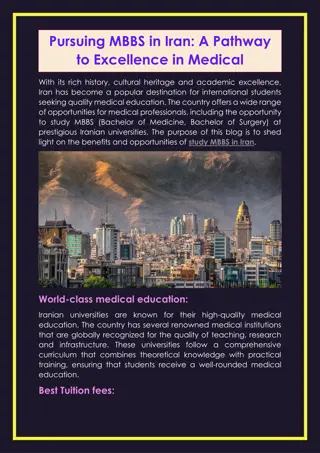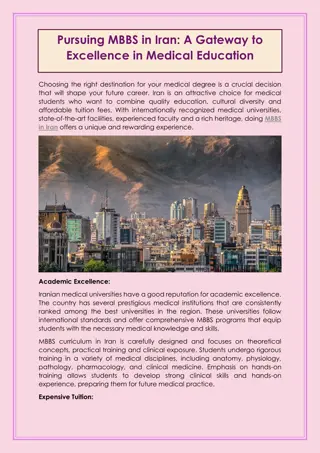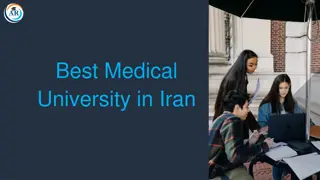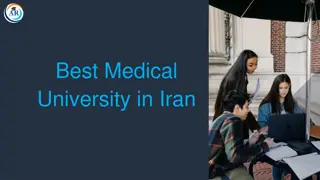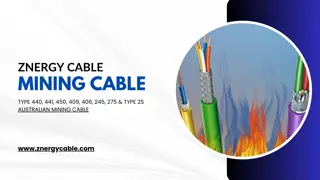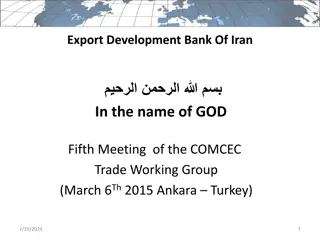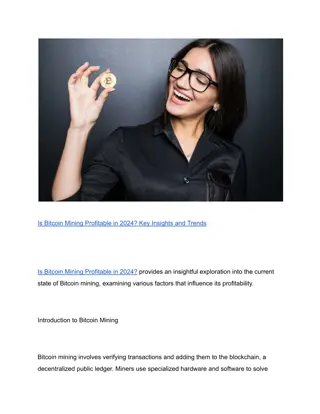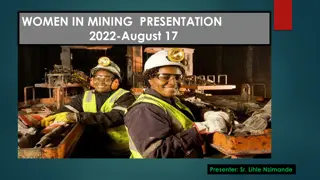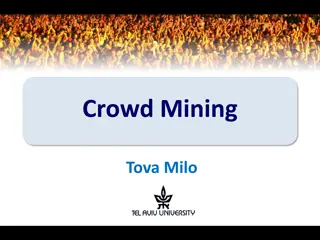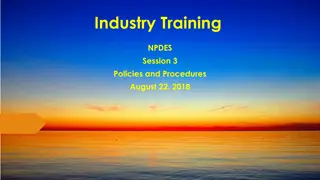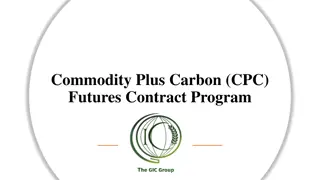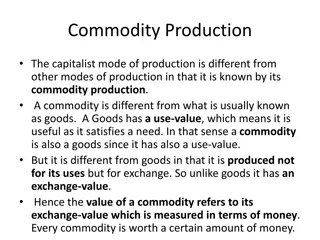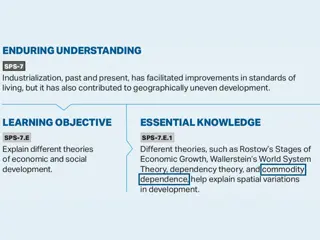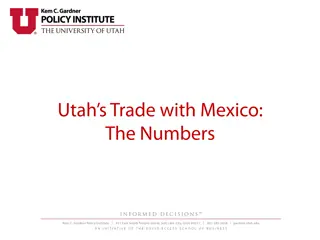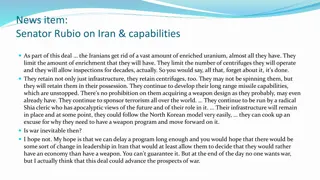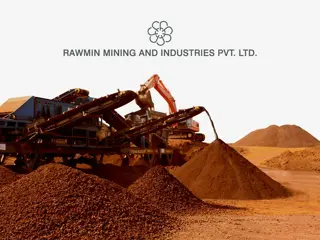
Iran: A Mining and Commodity Rich Country
Iran, a commodity-rich country, is attracting Western investors with its vast mineral reserves including large deposits of zinc, copper, iron, uranium, and lead. The country holds significant oil and gas reserves, making it an attractive destination for foreign investment. Government-owned companies like the National Iranian Oil Company and National Iranian Gas Company play a crucial role in the country's mining and energy sectors. With a focus on economic growth, Iran aims to leverage its abundant resources to drive development and attract international partnerships.
Download Presentation

Please find below an Image/Link to download the presentation.
The content on the website is provided AS IS for your information and personal use only. It may not be sold, licensed, or shared on other websites without obtaining consent from the author. If you encounter any issues during the download, it is possible that the publisher has removed the file from their server.
You are allowed to download the files provided on this website for personal or commercial use, subject to the condition that they are used lawfully. All files are the property of their respective owners.
The content on the website is provided AS IS for your information and personal use only. It may not be sold, licensed, or shared on other websites without obtaining consent from the author.
E N D
Presentation Transcript
IRAN A COMMODITY RICH COUNTRY Iran A MINING COUNTRY? Finity Asset Farzad Moshfeghi
Background After a 10 year absence, Western investors can re-invest in Iran. Iranian government has created a number of investor friendly schemes : free trade zones, favourable investment terms for foreigners regulatory schemes such as FIPPA and 100% ownership rights Below ground the value of assets has not disappeared. Iran needs to attract foreign investment and western partners to deliver an ambitious program of economic growth 4th largest Oil reserves (150B bbl) & 2nd largest Gas reserves (over 1000 Tcf) Iran accounts for roughly 1% of the world's population yet holds more than 18% of global gas reserves, 10% of global oil reserves and 7% of global mining reserves.
What is Iran Famous for ? Iran has the 4th largest Oil reserves approx. 150B bbls with hydro carbon fiels both in the south, west and north of the country. Most prominent field is the Ahvaz field with nearly 1M bbl/day. OIL & GAS Of course Iran has the second largest gas reserves in the world with approx. 1000 Tcf of proven reserves most famous is the South Pars field Over 140 oil and gas fields and nearly 300 reservoirse discovered so far.
What is Iran Famous for ? 37 billion tonnes of proven reserves and more than 57billion tonnes of potential reserves worth $770 billion - 2014. Iran holds more than 7% of the world's total mineral reserves Large deposits which mostly remain underdeveloped are : zinc (No 1 globally) copper (9th globally - 2011) iron (12th globally - 2013) uranium (10th globally) lead (11th globally). Approximately 5,000 operational mines producing 12 types of metals and 36 non-metal ores 90% of the mines belong to state owned companies (predominantly via IMIDRO) IMIDRO is openly looking for investors and partners to increase production and develop its assets - in particular copper, iron ore and aluminium MINERALS
Government companies are complex organizations Ministry of Industries, Mines and Trade www.mimt.gov.ir National Iranian Oil Company www.nioc.ir National Iranian Gas Company www.iraniangas.ir
How Iranian projects were funded historically Most large projects supported or executed by government controlled companies Finance secured via ECA s and soverign guarantees Lenders did not assume project risk so credit limits / risk management controls could be relaxed. Projects had little incentive to demonstrate commercial viability whilst guaranteed by CBI. Country Facts Population GDP GDP Growth 0.5% CPI CBI Deficit 77.45M 370BUSD 12.6% (down from 45) 2.7% Outlook: Iran is looking for short term boosts to its economy And aims to grow GDP by 4.8%
Irans ambitions Oil : Increase production to 5M BPD by 2021 Gas: Increase production to 1M BOEPD by 2020 Steel Increase to 55MT pa by 2025 Copper Increase to 500KT by 2020 Zinc Largest reserves globally, but maily Undeveloped Gold Increase to 320K Oz pa by end of 2017 Attract over $100B USD of investment
Hurdles for Iran Projects Primary Sanctions: USD transactions are forbidden under JCPOA. Moreover, use of US financial systems are also forbidden. European banks are unwilling to provide direct lending to Iranian companies in fear of US reprisals and in the absence of guarantees from US that fines would not be imposed. Iranian companies cannot list shares on European exchanges as most European shares are cleared through Clearstream which doesn t support Iranian stocks. Key Contributing Factors Iran capital markets are relatively small average daily trading volume is circa $100M USD compared with $4.3B USD for London No global custody support or centralised dividend collection/distribution. Very few Iranian companies practice IFRS, which means their valuations may be artificially inflated. Lack of financial advisory services means many Iranian corporates are unaware of the financial products available and the pre-requisites for qualifying (historically projects had to be guaranteed in order to be financed) In 2016 Iranian banks converted to IFRS and all but 2 private banks failed capitalisation requirements. IRFS compliance is a mandatory requirement to qualify for lending from European banks. Companies in natural resources sector do not comply with international standards 43-101, JORC, BFS or 51-101. Oil & Gas projects are government controlled and historically operated through Buy-Back contracts - unattractive in todays market. IOC s cannot book reserves- this has a direct impact on cost of capital (though the recently issued IPC allows for cost recovery through the sale of pre-allocated barrels of oil.) Most Iranian Companies accounts pre JCPOA display complexities due to the challenges of having had to operate under sanctions, especially for companies involved in any form of international trade. No direct lending to Iranian companies currently, unless supported by ECA.
Funding Roadmap Iran vs West Project Roadmap Start up Feasibility Production Scale Up Development 12 Risk/Value Profile of a stand alone project WEST 12 Risk/Value Profile of a guaranteed project IRAN 10 Risk Value 10 Risk Value 8 8 6 6 4 4 2 2 0 0 Start up Feasibility Development Production Scaleup Start up Feasibility Development Production Scaleup
Typical Funding Roadmap Iran vs West WEST Increase footprint Larger facilities Up to 100% Debt Construction Procurement DEBT & Equity (65% : 35% Ratio) Processing Off Take Up to 100% Debt Exploration Pre-Discovery 100% Equity CPR BFS 100% Equity Start up Feasibility Development Production Scale Up IRAN Without Sovereign Guarantee Internal resource report Internal feasibility report 100% Equity Construction Procurement Local Debt (with personal guarantee) & Equity Processing Off Take Local Debt (with personal guarantee) & Equity Increase footprint Larger facilities DITTO Exploration Pre-Discovery 100% Equity Start up Feasibility Development Production Scale Up
How the Western financial landscape has evolved IFRS introduced in 2001 Regulatory framework introduced for natural resource sector after Bre-X collapse- 43-101 introduced in 2001 for mining and 51-101 introduced for oil & gas introduced in 2002 Structured Lending introduced risk based finance solutions Banks in G10 countries adopted Basel Accord in 1992 with further refinements and restrictions in 2004 and 2013 Post Volcker ruling investment banks could not take part in prop trading and a host of hedge funds and specialist credit traders sprouted up to take up the business. New internal controls and credit committee restriction introduced major increase in Cost of capital Increased compliance controls (KYC/AML/CAPAD)
Financial Services West vs Iran Western Markets Advisory Services Valuations Independent analysis Investment banking Capitalisation advice M&A Transaction support Hedging support Tax and regulatory advice Seed and Venture capital Brokerage NOMAD Research IPO Execution support Daily Updates Tax advice Investor relations Investment banks IPO Fund raising M&A Structured lending Syndicated lending Issue Securities FX trading Commodities trading Derivatives products Hedge Funds Investment services Regulated activities Credit funds Private Equity Unregulated markets Private projects JV s Iranian Markets Advisory Services Very limited advisory services Brokerage Research IPO Execution support Investment banks IPO Fund raising M&A FX trading Banks not sufficiently capitalised for risk lending. They also insist on personal guarantees for any corporate loans. No syndicated lending Hedge Funds Long only equities funds Large government owned institutions and pension funds investing in large (mostly government controlled) businesses Private Equity Small number of PE funds covering mostly Tech and consumable sector.
Funding today - Short Term Plan Trade Finance is already available, but long term risk based financial products are in short supply. Government treaties and development agreements ECA finance available for projects with a strong guarantee (sovereign or ministry) JV and equity investments Offtake finance solutions.
Addressing Risks Long term plan Iran needs to put in place measures that will upgrade practices and systems to current global standards before it can tap into the financial markets for Project Finance: Adopt global standards such as JORC/43-101 or 51-101 and bankable feasibility studies to ensure investors can evaluate projects and risk before funding can be secured. Iranian banks should introduce western style structured products. Iranian banks should implement western compliance processes and apply prudent risk measures such as CapAd and Basel so they can take part in international syndications. Tehran Stock Exchange should adopt a viable IFRS conversion program for listed companies and put measures in place for the economic impact of valuations on the TSE indices. The Central Bank should introduce currency solutions backed by trade agreements so that FX volatility is reduced. Review of mining laws and decentralisation of natural resources projects so that PE funds and junior mining companies can invest in the sector.
Thank you and Q&A Operating since 2012 from its London headquarters, Finity Asset focus on funding solutions for the natural resources and energy sectors. For any further queries please contact us on Land Line: +44 207 486 6183 Email: info@finityasset.com

